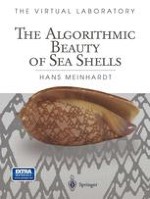1995 | OriginalPaper | Buchkapitel
The big problem: two or more time-dependent patterns that cause interference
verfasst von : Hans Meinhardt
Erschienen in: The Algorithmic Beauty of Sea Shells
Verlag: Springer Berlin Heidelberg
Enthalten in: Professional Book Archive
Aktivieren Sie unsere intelligente Suche, um passende Fachinhalte oder Patente zu finden.
Wählen Sie Textabschnitte aus um mit Künstlicher Intelligenz passenden Patente zu finden. powered by
Markieren Sie Textabschnitte, um KI-gestützt weitere passende Inhalte zu finden. powered by
Many shells show patterns far more complex than those simulated so far. Figure 7.1 contains a collection of typical complex shell patterns. To show their inherent similarities, they are arranged such that each subsequent pattern contains elements of the preceding pattern as well as new features. Conus marmoreus (Figure 7.1a) shows white drop-like regions on a dark pigmented background. In Conus nobilis marchionatus (Figure 7.1b) the white drops are enlarged at the expense of the pigmented regions. The pattern is reminiscent of staggered wine glasses. Conus pennaceus (Figure 7.1c) shows, in addition, dark lines on a pigmented background, occasionally interrupted by small white drops. In Conus auratus (Figure 7.1d) the dark lines are maintained without the white drops. Instead, a periodic large-scale transition to oblique lines with crossings occurs. Shortly before this transition the continuous background resolves into narrow lines parallel to the growing edge (arrow). Such axially oriented parallel lines on top of a pigmented background are a characteristic pattern element in Conus textile (Figure 7.1e). Unpigmented regions with a drop-like shape occasionally appear. Their lower borders are formed by a dark pigmented line. In regions without pigmented background the pattern displays fine lines with wine glass shape as mentioned above. Similar parallel lines with occasional loops (tongues) are characteristic of Clithon (or Neritina) oualaniensis (Figure 7.1f). Here, however, the regions with fine lines are missing.
